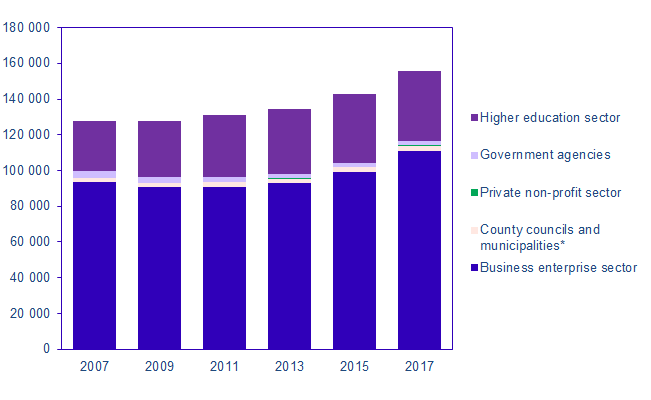Research and Development in Sweden 2017
Research and development in Sweden in 2017
Statistical news from Statistics Sweden 2019-03-14 9.30
In 2017, SEK 155.5 billion was invested in research and development (R&D) in Sweden, up by SEK 13 billion from 2015. The trend of increasing costs and expenses for R&D in Sweden is continuing, driven by the business enterprise sector, according to the Statistics Sweden report “Research and development in Sweden in 2017” .
Total expenditure and personnel allocated to research and development (R&D) in Sweden are examined every second year. Four sectors are examined: the business enterprise sector, the higher education sector, the government sector and the private non-profit sector.
Research and development expenditure in Sweden
In 2017, intramural R&D expenditure in Sweden amounted to SEK 155.5 billion in total. This is an increase of SEK 13 billion, which corresponds to 8 percent, from 2015, in 2017 prices. Over the past ten years, total R&D expenditure has increased each survey year, although there have been variations in individual sectors between the years. The business enterprise sector was the sector that increased the most since the 2015 survey. Intramural R&D expenditure in the business enterprise sector increased by SEK 11.8 billion in fixed prices between 2015 and 2017.

*Excluding ALF funding.
Business enterprise sector is the largest performer
The business enterprise sector accounted for SEK 110.9 billion, just under 71 percent, of total intramural R&D expenditure. The higher education sector performed R&D for SEK 38.8 billion, while R&D expenditure in the government sector amounted to SEK 5.6 billion, not including ALF funding. The private non-profit sector conducted R&D for SEK 185 million.
Men remain in the majority
Just under 132 000 people – 65 percent men and 35 percent women – were engaged in R&D activities in 2017. The gender ratio has remained virtually unchanged over the last ten years. Between 2015 and 2017, the number of people in R&D increased by just over 7 700. The business enterprise sector accounted for the largest rise, with an increase of 6 900 persons, which led to 76 000 in total. The number of employees in R&D at the county councils also increased substantially, just over 3 700 more persons were involved in R&D activities in 2017 compared with 2015. There were 12 000 persons in total in R&D at the county councils.
| Year | Business enterprise sector | County councils and municipalities* | Government agencies | Higher education sector | Private non-profit sector | Total |
|---|---|---|---|---|---|---|
| 2007 | 93 394 | 2 391 | 3 931 | 28 052 | 213 | 127 982 |
| 2009 | 90 668 | 2 416 | 3 173 | 31 476 | 95 | 127 828 |
| 2011 | 90 496 | 2 860 | 2 874 | 34 453 | 417 | 131 100 |
| 2013 | 92 787 | 2 504 | 2 535 | 36 554 | 302 | 134 682 |
| 2015 | 99 345 | 2 380 | 2 493 | 38 075 | 264 | 142 557 |
| 2017 | 110 933 | 2 931 | 2 701 | 38 781 | 185 | 155 531 |
*Excluding ALF funding.
“Researcher” was most common occupation
There were roughly 88 000 R&D full-time equivalents (FTEs) performed in Sweden in 2017. The business enterprise sector accounted for 73 percent and the higher education sector 22 percent of the total. The share of women with the occupation researcher was 75 percent among all R&D FTEs performed by women.
Definitions and explanations
Intramural R&D
Activities carried out in Sweden by the organisation’s own personnel, or by consultants in an R&D project led by the organisation, where the organisation’s personnel have worked together with consultants. Intramural R&D includes R&D assigned by other parties.
R&D expenditure
R&D expenditure includes current expenditure and investments for intramural R&D. Current expenditure refers to labour costs, consultant fees, and other current expenditures. Investments include buildings, land and real estate, machinery and equipment, and software.
Full time equivalent
A full time equivalent (FTE), or person-year, is the work that one full-time employee does in one year. A full-time employee that spends half of their time on R&D in a year has therefore carried out 0.5 R&D FTEs.
ALF funding
ALF (Agreement for Medical Training and Research) refers to an agreement about compensation that the central government pays to certain county councils to cover the majority of costs incurred by clinical training and research.
Publication
For more information on the development of R&D in Sweden, please see the full report “Research and development in Sweden in 2017”.
Statistical Database
More information is available in the Statistical Database
Feel free to use the facts from this statistical news but remember to state Source: Statistics Sweden.
